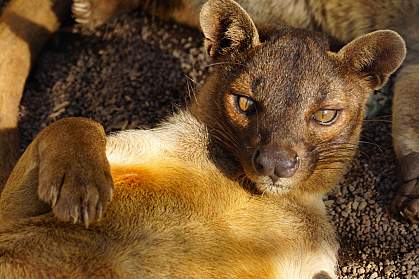You are here
March 26, 2012
Carnivores Lack Taste for Sweets

Some meat-eating mammals have lost their ability to taste sweetness in foods, and those that swallow their food whole may lack bitter and savory tastes. These new findings suggest that certain unneeded taste receptors may be lost through evolution.
Humans and other omnivores that eat a wide range of foods have 5 basic types of taste receptors—sweet, bitter, salty, sour and savory (also called unami). Found on the surface of taste cells in the tongue, these receptors selectively bind to food molecules of just the right shape. These interactions trigger signals that travel through nerve cells to the brain and give us the sensation of taste.
Earlier research by Dr. Gary Beauchamp of the Monell Chemical Senses Center in Philadelphia showed that domestic and wild cats showed no preference for sweet-tasting foods. More recently, he and his colleagues reported that these cats have defects in the Tas1r2 gene, which codes for a key portion of the sweet taste receptor. The scientists reasoned that this malfunctioning gene might underlie the cats' reliance on a meat-based diet and indifference to sweeter plant-based foods.
To test this theory on other meat-eating animals, the researchers sequenced Tas1r2 genes from 12 species of non-feline carnivores (order Carnivora). The study was supported by NIH's National Institute on Deafness and Other Communication Disorders (NIDCD).
As reported in the March 12, 2012, online edition of the Proceedings of the National Academy of Sciences, 7 of the 12 tested species had flaws in the Tas1r2 gene. They include the sea lion, fur seal, harbor seal, Asian otter, spotted hyena and 2 cat-like creatures (fossa and banded linsang). All are strict meat eaters. These species, however, have differing mutations that disrupt Tas1r2. The researchers suspect that the gene may have been damaged and lost independently as these carnivores evolved toward exclusive meat-eating diets.
The remaining 5 species—including both omnivores and exclusive meat eaters—all had intact and functional Tas1r2 genes. These species include the spectacled bear, Canadian otter, raccoon, red wolf and aardwolf.
In behavioral tests, the researchers found that the Asian otter, with defective Tas1r2, showed no preference for sweet foods. But the omnivorous spectacled bear, with intact Tas1r2, strongly preferred foods with natural sugar or even no-calorie sweeteners.
To see if other taste qualities might be lost if not needed, the researchers examined taste receptor genes in 2 distantly related sea-dwelling mammals that tend to swallow their food whole: the sea lion (Carnivora) and bottlenose dolphin (order Cetacea). With this unusual eating behavior, they're thought to barely taste what they're eating. Both species, the scientists discovered, have defects in genes for sweet and unami receptors. Dolphins also appear to lack functional genes for bitter receptors.
“Sweet taste was thought to be nearly a universal trait in animals. That evolution has independently led to its loss in so many different species was quite unexpected,” says Beauchamp.
These findings suggest that loss of taste may be more common than previously thought, and that taste receptor function may align with an animal's feeding strategy.
—by Vicki Contie
Related Links
References: Proc Natl Acad Sci U S A 2012 Mar 12. [Epub ahead of print].
